Carrots are one of the most rewarding vegetables to grow in your garden. Their bright orange roots add color and nutrition to your meals, and cultivating them from seed is both simple and satisfying. With a little planning and care, you can transform any garden patch into a thriving carrot bed that produces abundant, healthy roots in record time. Here’s how to get started and maximize your carrot harvest quickly.
1. Choose the Right Carrot Variety
There are many carrot varieties, each with unique colors, shapes, and flavors. For fast growth and impressive harvests, select early-maturing or “baby” carrot varieties such as:
-
‘Early Nantes’ — Known for its sweet flavor and tender texture.
-
‘Thumbelina’ — A small, round carrot that matures quickly.
-
‘Danvers’ — A classic, reliable variety with good disease resistance.
-
‘Little Finger’ — Produces slender roots ideal for containers and small spaces.
Choose a variety suited to your climate and garden space for the best results.
2. Prepare Your Soil Properly
Carrots need loose, well-draining soil free of stones and debris for straight, healthy roots. Heavy clay or compacted soils can stunt growth and cause misshapen carrots.
-
Loosen the soil to a depth of at least 12 inches (30 cm).
-
Work in plenty of organic matter such as compost or well-rotted manure to improve texture and fertility.
-
Avoid fresh manure, which can encourage forked roots and pest problems.
-
Test soil pH and aim for a slightly acidic to neutral range of 6.0 to 7.0.
Good soil preparation is the foundation of a stunning carrot crop.
3. Sow Seeds Correctly
Carrot seeds are tiny and slow to germinate, but the sowing technique can speed up the process:
-
Sow seeds directly where you want the carrots to grow; they don’t transplant well.
-
Plant seeds about ¼ inch (0.6 cm) deep in rows spaced 12-18 inches apart.
-
To improve germination, soak seeds overnight in water or cover rows with a damp cloth or plastic wrap until sprouts appear.
-
Thin seedlings to 2-3 inches (5-7 cm) apart as they grow to prevent overcrowding and allow roots to develop fully.
Consistent moisture and warmth are essential during germination, which typically takes 10-21 days.
4. Provide Consistent Watering
Carrots require even moisture for rapid growth and to avoid splitting or tough skins.
-
Water deeply once or twice a week, depending on rainfall and temperature.
-
Avoid overhead watering to reduce the risk of fungal diseases.
-
Mulch around the rows with straw or shredded leaves to retain soil moisture and regulate temperature.
Keep soil moist but never waterlogged to support steady growth.
5. Feed Your Carrots
Though carrots don’t need heavy feeding, balanced nutrition accelerates root development.
-
Use a fertilizer low in nitrogen but higher in phosphorus and potassium (e.g., 5-10-10) to encourage root growth rather than leafy tops.
-
Apply fertilizer at planting and again midway through the growing cycle.
-
Organic options like bone meal or kelp meal work well.
Avoid too much nitrogen fertilizer, which encourages lush foliage but weak roots.
6. Control Weeds and Pests
A clean, weed-free garden ensures your carrots don’t compete for nutrients or water.
-
Weed gently by hand or with shallow cultivation to avoid disturbing roots.
-
Watch for common pests like carrot flies, aphids, and root-knot nematodes.
-
Use floating row covers to protect young carrots from carrot fly eggs.
-
Encourage beneficial insects such as ladybugs and lacewings to control aphids naturally.
Regular monitoring keeps problems minimal and harvests stunning.
7. Harvesting at the Right Time
Early varieties can be ready to harvest in as little as 60 days.
-
Pull carrots when roots reach a desirable size (usually ½ to 1 inch in diameter).
-
Harvest young carrots often to encourage continuous production.
-
Loosen soil around roots before pulling to avoid breakage.
-
For storage, harvest after a light frost—it sweetens the roots and extends shelf life.
Freshly harvested carrots are crisp, sweet, and far superior to store-bought.
8. Extend Your Growing Season
To transform your garden quickly and enjoy fresh carrots longer:
-
Succession plant every 2-3 weeks for continuous harvests.
-
Use raised beds or containers to warm soil faster in spring.
-
Try growing carrots under cold frames or row covers in early spring or late fall.
These techniques help you get more from your garden with minimal extra effort.
Final Thoughts
Carrots are a fantastic addition to any garden, offering color, flavor, and nutrition with relatively little fuss. By choosing the right varieties, preparing your soil properly, and providing consistent care, you can achieve a bountiful carrot harvest in record time. Whether you’re a beginner or a seasoned gardener, these tips will help you grow carrots that transform your garden into a stunning, productive space.



